Site Study: Giant hogweed control on the Lemno Water, River South Esk
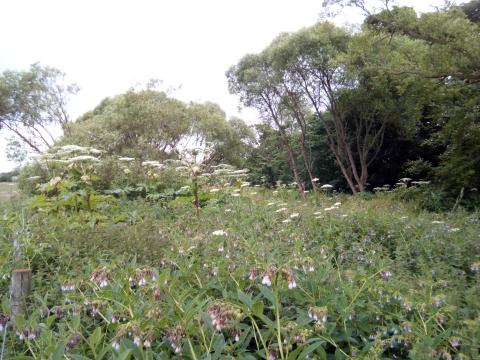
Summary
The Lemno Water is a tributary of the river South Esk in Angus. In 2018 it was identified by the Scottish Invasive Species Initiative as a significant source of giant hogweed contributing to the large-scale hogweed problems experienced downstream on the South Esk as well as being a problem site in its own right where the plant dominated large sections, caused bank collapse and silting and outcompeted native species.
Giant hogweed had grown on the Lemno Water for many years and there was no evidence of any control effort having been made there in the past. Working with contractors (to tackle the problem when at its worst) and volunteers the Scottish Invasive Species Initiative has undertaken control at the site from 2018-2021. Based on annual survey results and records of control effort and the chemical volume applied this work reduced the abundance of giant hogweed present and, as a result, the effort required to deliver annual control.
Annual monitoring and control will be undertaken by the Scottish Invasive Species Initiative in 2022 but this work will be needed for a number of years beyond then to treat the giant hogweed seedlings which will emerge from the seedbank present in the soil. By preventing plant maturation, seed setting and dispersal the seed bank will be progressively diminished and the infestation reduced. This will take several years but is now a more manageable task.
Discussions will take place in 2022 which will look to transfer this ongoing management responsibility to relevant land owners and land managers.
1. Site description
The Lemno Water site is a 1.8km river length which runs through mixed use agricultural land and a small area of woodland before joining the river South Esk at Finavon Castle in Angus. The section starts just upstream of West Mains of Finavon (Grid ref. NO 48589 56364) and ends at the confluence with the South Esk (Grid ref. NO 50076 56564, see Map 1 below). The site has been significantly modified and straightened as part of past agricultural management activities.
Ownership is shared by farmers and the local Finavon estate with no-one having overall management responsibility for the site. Within the Scottish Invasive Species Initiative partnership the South Esk catchment is covered by the Esks District Salmon Fishery Board.
Map 1: Location of the site on the Lemno Water, before the confluence with the South Esk at Finavon Castle.

2. Background
Giant hogweed has been present in the South Esk catchment for many decades and is well established in many locations. Within the Lemno Water, giant hogweed was spread along the entire section as a mix of single plants and small patches and with a particularly dense growth area (circled on map above) in the upper part of the site where it was causing bank collapse, silting of the water and outcompeting native species.
There was no evidence of any prior control work having been undertaken. The giant hogweed growth on the Lemno Water was acting as a key seed source to the heavily infested downstream area at Finavon Castle which, itself, was supporting further downstream spread into the River South Esk from growth there.
The Lemno Water was identified for control by the Scottish Invasive Species Initiative in mid-2018, by which time giant hogweed plants were starting to flower. With the agreement of landowners, attempts were made that year to prevent seeding by removing flower heads and chemical application and to allow a more organised strategy to be developed for 2019 and beyond. Due to the severity of the infestation on the Lemon Water it was decided to deploy contractors to the site to try and bring the infestation into a more locally manageable position.
3. Management works
The giant hogweed on the Lemno Water was treated for the first time in 2018 with annual control continued in 2019, 2020 and 2021. Glyphosate (Round-up ProVantage) was applied by foliar spray (spraying directly onto the leaves of the plant) by backpack sprayer with a single application made in each year. Removal of flowering heads by manual cutting was also carried out in both 2018 and 2020.
In 2018 control was completed by project staff and volunteers to try to prevent seeding and further spread in that year. Due to the severity of the infestation contractors were used in 2019, 2020 and 2021 to try and reduce the level of infestation present. In 2021, as giant hogweed abundance was beginning to be reduced, project staff also worked at the site.
Table 1 below shows a summary of the control treatments.
Table 1 - Summary of control treatments at Lemno Water, Finavon Castle, South Esk (2018 - 2021)
| Year | Invasive Species | Work Completed by | Control work (date and method) | |||
|---|---|---|---|---|---|---|
| 2018 | Giant hogweed | Project staff and volunteers | July - foliar spray and flower head removal | |||
| 2019 | Giant hogweed | Contractors | May - foliar spray | |||
| 2020 | Giant hogweed | Contractors | June - foliar spray and flower head removal | |||
| 2021 | Giant hogweed | Project staff and contractors | June - foliar spray |
4. Results
4.1 Invasive species abundance
When work began at Lemno Water in 2018, giant hogweed abundance was recorded as ‘dominant’ using the DAFOR scale* (see Table 2).
Following treatment that year and then in 2019, 2020 and 2021, a gradual reduction in giant hogweed abundance was recorded. In 2019 and 2020 hogweed was recorded as ‘abundant’ and in 2021 the plant was recorded as ‘frequent’ at the site (see Figure 1).
The abundance of invasive species was measured using the DAFOR scale and is shown in Table 2 below.
Table 2 - Annual giant hogweed abundance at Lemno Water, Finavon Castle, South Esk (2018 - 2021)
| Giant hogweed abundance by year (DAFOR scale*) | |||
|---|---|---|---|
| 2018 | 2019 | 2020 | 2021 |
| D | A | A | F |
* - DAFOR Scale of abundance – D = Dominant (50 – 100% cover), A = Abundant (30 – 50% cover), F = Frequent (15 – 30% cover), O = Occasional (5 – 15 % cover), R = Rare (<5% cover)
Figure 1: Giant hogweed at Lemno Water, Finavon Castle, South Esk, 2018 - 2021
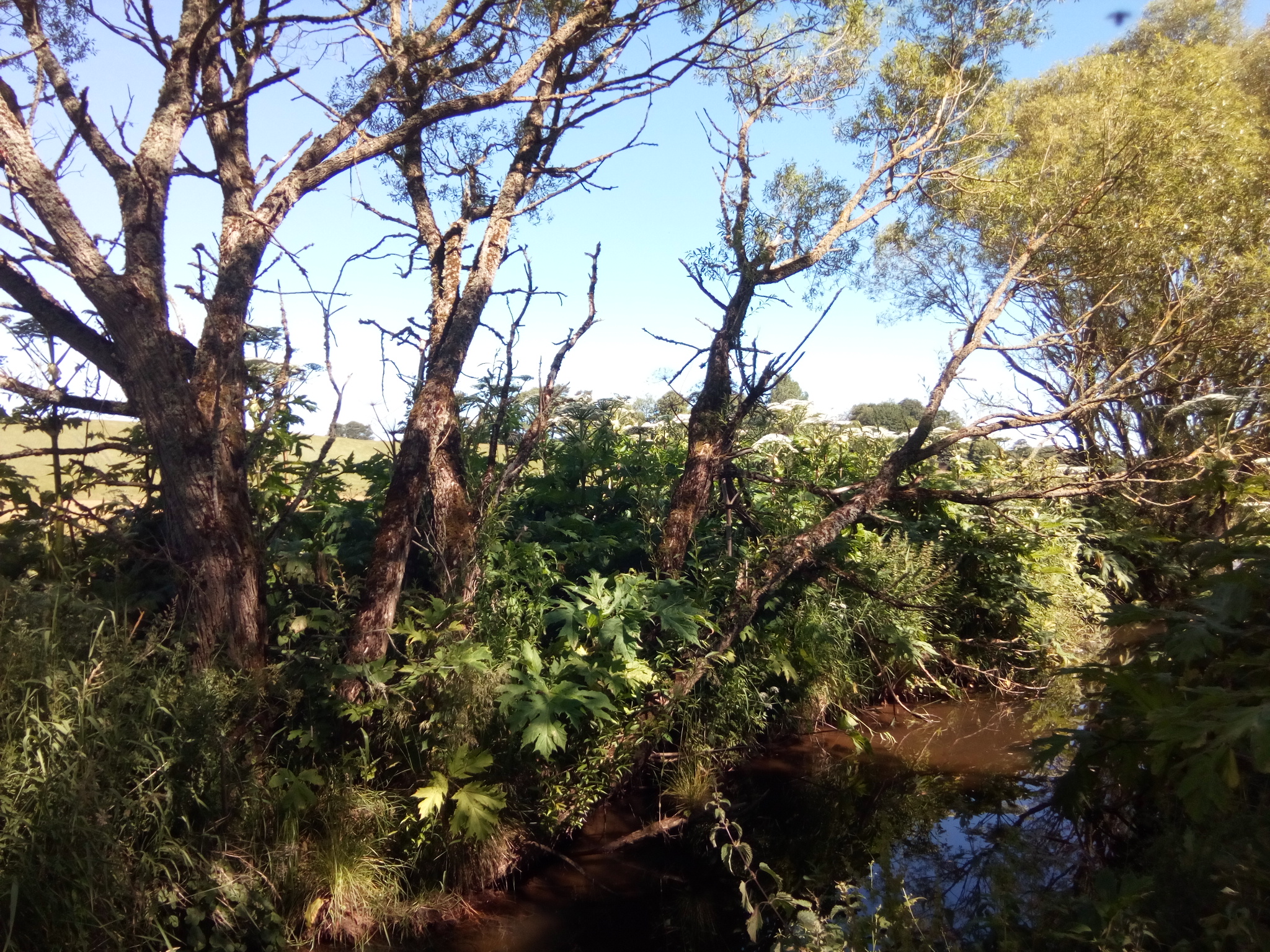 |
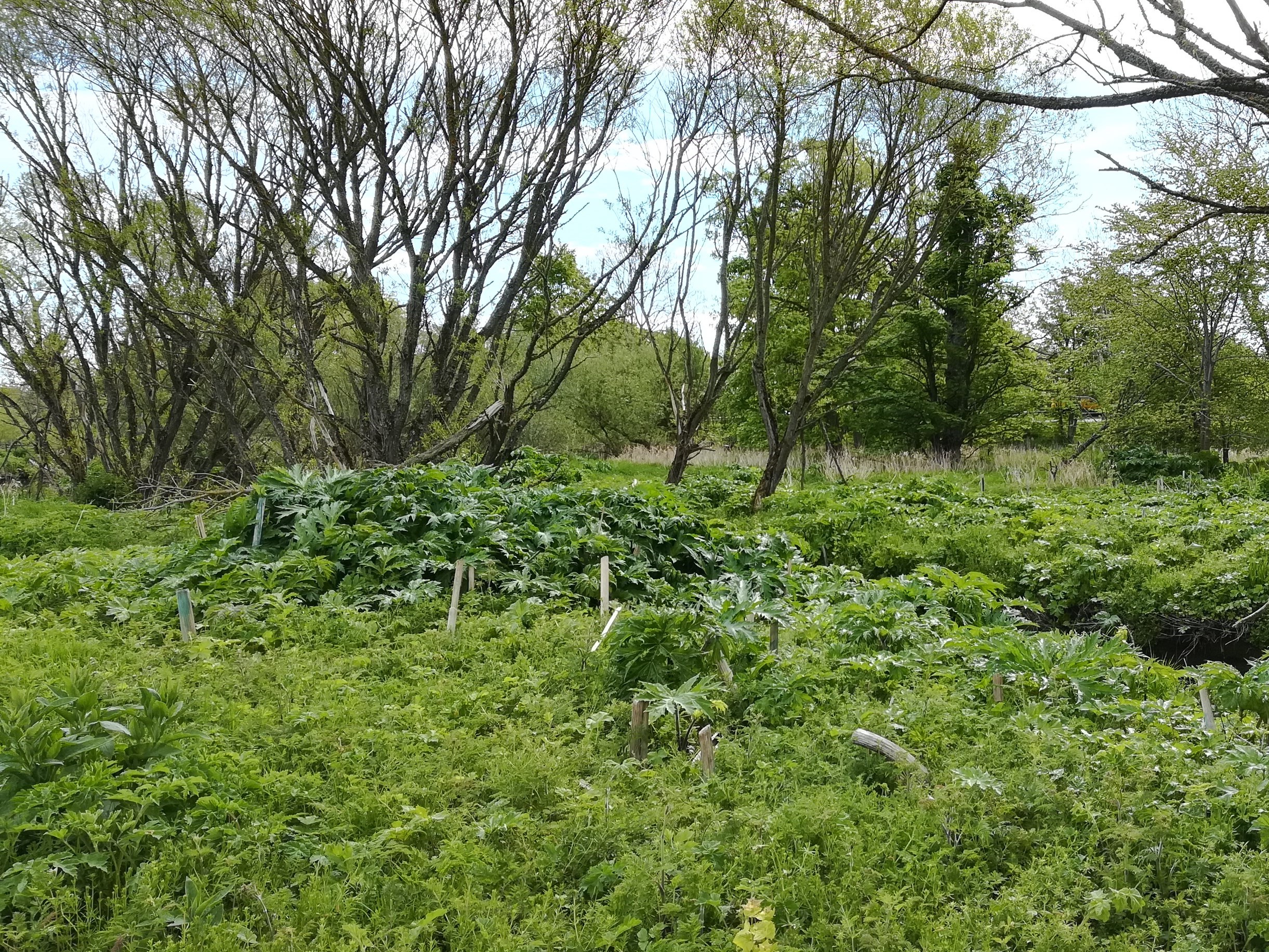 |
|
| Figure 1a – 2018 prior to any treatment on site. Flowering giant hogweed visible, dominating the site. | Figure 1b - early in season 2019. Photo taken before control, giant hogweed 'abundant' on site with numerous mature plants present. | |
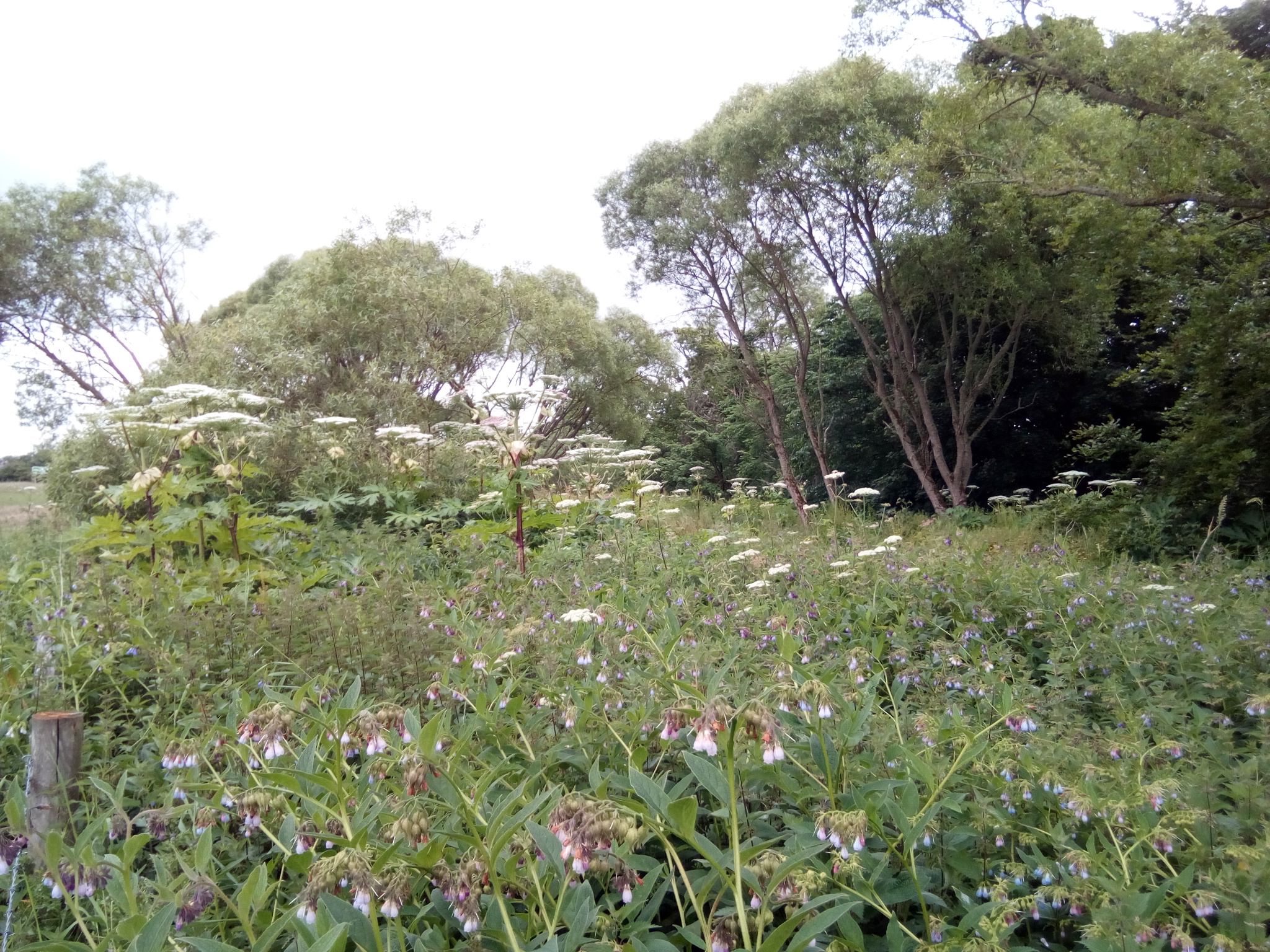 |
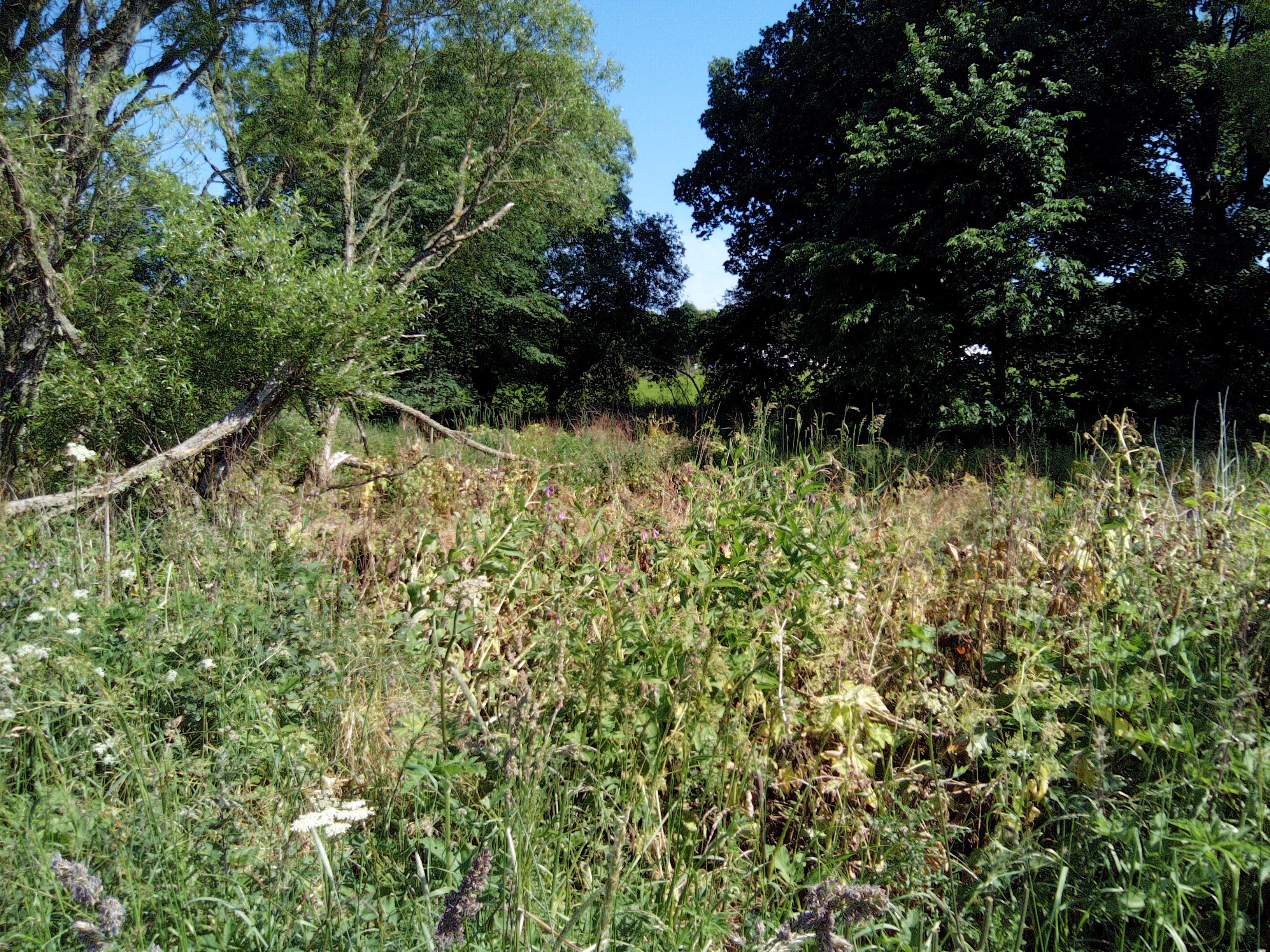 |
|
| Figure 1c - pre-treatment 2020. Treatment delayed by Covid-19 pandemic. Giant hogweed still 'abundant' on site with large third year plants present. | Figure 1d - post treatment 2021. Giant hogweed abundance still 'frequent' at this point. Photo taken after contractors undertook control. Giant hogweed visible as brown areas of dead vegetation. |
4.2 Chemical usage
In all years of treatment glyphosate was applied by backpack sprayer at concentration of 20ml per litre. The volume of glyphosate used per year is shown in Table 3 (below).
Table 3 - Glyphosate volume used to control giant hogweed at Lemno Water, South Esk (2018 - 2021)
| Glyphosate used (litres) by year | |||
|---|---|---|---|
| 2018 | 2019 | 2020 | 2021 |
| 2.6 | 1.9 | 1.8 | 0.8 |
4.3 People effort
Control work was undertaken by Scottish Invasive Species Initiative staff and volunteers in 2018, by contractors in 2019 and 2020 and by a combination of contractors and project staff in 2021. Table 4 (below) shows the effort in terms of hours of control work spent at the site.
Table 4 - People hours used to control giant hogweed at Lemno Water, South Esk (2018 - 2021)
| Hours of control work by year | |||
|---|---|---|---|
| 2018 | 2019 | 2020 | 2021 |
| 34 | 16 | 20 | 12 |
5. Conclusions and Progress Made
The ongoing control work at Lemno Water from 2018 is starting to reduce the abundance of giant hogweed at the site and both the time and chemical volume required to deliver annual control.
This is demonstrated by the change in abundance of the plant at monitoring points - which show a reduction in the extent of giant hogweed observed – and in DAFOR scores at these locations (see Table 2) which recorded abundance reducing from ‘dominant’ (2018) to ‘abundant’ (2019 and 2020) and then ‘frequent’ in 2021.
Progress is also shown in both the hours of work needed to treat the giant hogweed infestation and the chemical volume use in this treatment. Hours required to control, and chemical volume used, reduced by 65% and 69% respectively between 2018 and 2021.
This is encouraging progress but giant hogweed control is likely to be required here for a number of additional years to further reduce abundance of the plant. Giant hogweed has been well established on the Lemno Water for a significant period and, following many years of successful flowering and seed dispersal, a large seed bank will be present in the soil. Seeds remain viable for many years and so only by maintaining annual control and preventing further seed dispersal will the problem be further reduced.
Based on giant hogweed abundance and control effort in 2021, the intention in 2022 is for project staff and volunteers to undertake necessary control work without contractor support. This is consistent with the Scottish Invasive Species Initiative model of bringing sites under control and then transferring future management responsibilities to land managers, communities and/or volunteers. This is more possible when ongoing management can be delivered without the costs of contractor labour. The contractor efforts of 2019, 2020 and 2021 have been critical in bringing about the observed reduction in giant hogweed abundance so that this type of transfer is now more possible on the Lemno Water.
By preventing seed dispersal from the Lemno Water the site will no longer be a source of infestation to locations such as Finavon Castle downstream. This means that control work at such downstream sites can be continued in the knowledge that seeds are not being reintroduced to the site from upstream sources.
6. Next Steps
Giant hogweed seedlings will continue to emerge at the Lemno Water site in 2022 and beyond due to the persistent seed bank in the soil.
The primary objective at the site is to continue to control these annually emerging plants to prevent them maturing and setting seed. If achieved the extent of regrowth will decline as the seed bank is exhausted and, in time, the site will more towards being clear of giant hogweed. However, this will take a number of years to achieve and require annual monitoring and control.
The site will be monitored and controlled in 2022 by project staff and volunteers. In addition, discussions will be initiated with the land managers and land owners to seek to transfer responsibility for ongoing monitoring and control to them now that these annual and recurring tasks are more manageable. If such agreements are secured this will allow future giant hogweed control work to target sites downstream in the knowledge that the Lemno Water will be controlled by relevant land managers.
The Scottish Invasive Species Initiative ends in October 2022. Therefore, such local agreements are essential to protect the significant gains made through the control delivered by the project since 2018. It remains to be seen whether land owners and managers on the Lemno Water will accept this responsibility given the lack of control at the site in previous years.
Further information
Contact: [email protected]
